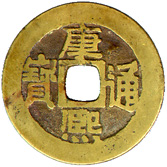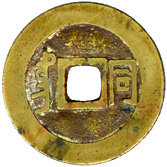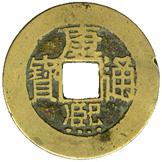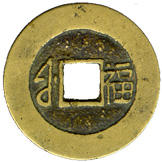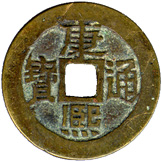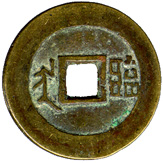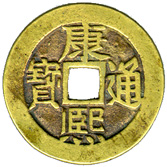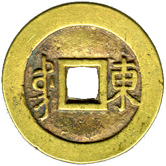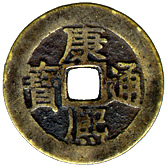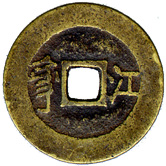|
In 1661, The young Shun Chih Emperor caught smallpox and passed
away. His third son, Hsuan Yeh  was
chosen to succeed the throne at the age of eight with the reign
title K'ang Hsi. The Emperor K'ang Hsi had reigned China for
61 years. His long and prosperous reign periods was famous not
only of the Qing dynasty but of the whole of Chinese history.
When he passed away in 1722, he left a flourshng and stable kingdom. was
chosen to succeed the throne at the age of eight with the reign
title K'ang Hsi. The Emperor K'ang Hsi had reigned China for
61 years. His long and prosperous reign periods was famous not
only of the Qing dynasty but of the whole of Chinese history.
When he passed away in 1722, he left a flourshng and stable kingdom.
The coinage of the K'ang Hsi series is very interesting. Have
you heard about the K'ang Hsi Ch'ien Shih  ? It
was arranged by the Chinese collector with the different mints
in the form of a Chinese poetry during the Chien Long period
and now it is the favourite target for the Chinese collectors. ? It
was arranged by the Chinese collector with the different mints
in the form of a Chinese poetry during the Chien Long period
and now it is the favourite target for the Chinese collectors.

T'ung |

Fu |

Lin |

Tung |

Chiang, |

Hsuan |

Yuan |

Su |

Chi |

Ch'ang, |

Nan |

Ho |

Ning |

Kuang |

Che, |

T'ai |

Kuei |

Shen |

Yun |

Chang. |
I give below is an interesting belief wrote by Mr. Fr. Schjoth
in 1929. I came across it in my reading a few weeks before.
|
Mr. Fr. Schjoth wrote:
The Chinese attach a talismanic virtue
to the above coins. If genuine and placed together, they have
the power of expelling evil influences and of preventing fires.
Their genuineness according to popular belief can be tested by
placing them, when strung together, on the top of a chickencoop:
If genuine, they will prevent the cocks from crowing in the morning
! |
The coinage of K'ang Hsi reign followed the forms of the last
two issues of the Shun Chih coin. The obverse of the coins bearing
with the reign title of the Emperor K'ang Hsi, along with the
characters "T'ung Pao" in Chinese. The reverse of the
coins, except those cast by the two principal mints in Peking,
Kung-pu Pao Yuan Chu  [Board of Works] and Hu-pu Pao Ch'uan Chu
[Board of Works] and Hu-pu Pao Ch'uan Chu  [Board of Revenue], all the provincial
K'ang Hsi coins, show the mint mark in Manchu script [left] along
with the mint mark [right] in Han script. The mint marks of the
two principal mints were written in Manchu scripts only, appear
on either side of the hole on the reverse. The forms are consistent
until the beginning of the Yung Zheng coinage. But the number
of the provincial mints was often changed. This was certainly
caused by the increased or decreased work in connection with
the cash production. In 1662, most of the provincial mints were
terminated casting coins except Kiangsi Mint (Nanchang) and the
two principal mints in Peking. It might be because of the over
supply of the copper cash or the price of cash was too low at
the beginning of K'ang Hsi reign.*
[Board of Revenue], all the provincial
K'ang Hsi coins, show the mint mark in Manchu script [left] along
with the mint mark [right] in Han script. The mint marks of the
two principal mints were written in Manchu scripts only, appear
on either side of the hole on the reverse. The forms are consistent
until the beginning of the Yung Zheng coinage. But the number
of the provincial mints was often changed. This was certainly
caused by the increased or decreased work in connection with
the cash production. In 1662, most of the provincial mints were
terminated casting coins except Kiangsi Mint (Nanchang) and the
two principal mints in Peking. It might be because of the over
supply of the copper cash or the price of cash was too low at
the beginning of K'ang Hsi reign.*
All the provincial mints were reopened in 1667. But I believe
that a limited amount of K'ang Hsi T'ung Pao were possibly cast
by the provinceial mints in 1661.
I have selected 25 pieces of K'ang Hsi T'ung Pao coin from my
collection and divide them into 5 parts showing here. All the
K'ang Hsi cash would be shown with a detailed description.
*
[The Official exchange rate of copper
cash to silver was 1000 to 1 (1000 standard cash to 1 tael of
silver). Actually, the changes in the cash-silver exchange rate
were determined by the natural economic forces. Sometimes when
the ingredients contained in a copper cash became more valuable
than its face value, copper cash were melted down by the criminals
in order to get the copper.] |
